|
I) Observing Weather
A) Properties of the Atmosphere
1) Mixture of gases
(a) Nitrogen
(b) Oxygen
(c) Carbon dioxide
(d) Ozone
(e) Other trace gases
2) Reaches from Earth’s surface to edge of space
3) Resource
(a) Life
4) Protection
(a) Radiation
(b) Temperature extremes
5) Layers of atmosphere
(a) Troposphere
(1) Closest to ground
(b) Stratosphere
(1) Contains ozone
(i) Blocks harmful radiation
(c) Mesosphere
(1) Temperature decreases
(i) Coldest spot in atmosphere
(d) Thermosphere
(1) Warmed by ultraviolet light
(2) Ionosphere
(i) Region where molecules have absorbed so much
ultraviolet energy they become ionized
B) Observing the Weather
1) Instruments
(a) Temperature
(1) Thermometer
(b) Wind
(1) Wind vane
(i) Direction
(2) Anemometer
(i) Speed
(c) Pressure
(1) Barometer
(d) Humidity
(1) Hygrometers
(i) Relative humidity
1. amount of water vapor in the air compared to
the greatest amount the air can hold
(e) Cloud cover
(1) Measure as a percentage of the amount of sky
covered by clouds
(f) Precipitation
(1) Precipitation gauge
(i) Rain, snow, hail, sleet
2) Other instruments
(a) Computers
(b) Radiosonde
(1) Measures weather conditions high above the
ground
(c) Radar
(d) Satellites
C) Reading Weather Data and Weather Patterns
1) Isobars
(a) Lines connecting places of equal pressure
2) Isotherms
(a) Lines connecting places of equal temperature
3) Air Masses
(a) A large region of air with similar
properties throughout
(1) Maritime Polar
(i) Cool and moist
(2) Continental Polar
(i) Cool and dry
(3) Maritime Tropical
(i) Warm and moist
(4) Continental Tropical
(i) Warm and dry
4) Fronts
(a) Boundary between two different air masses
(1) Cold front
(i) Cold air moves in, pushing warm air above it
(2) Warm front
(i) Warm air moves in, pushing out cold air
(3) Occluded front
(i) One cold front overtakes a warm front and
joins with another cold front
(4) Stationary front
(i) Front that does not move
|

Percentage of
Various Gases in Air |
|
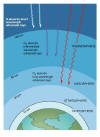
Life protecting layers of O, O2,
and O3 in the atmosphere absorb lethal ultraviolet radiation. |
|
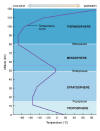
The variation of temperature with
altitude in the atmosphere
The atmosphere is
divided into four temperature zones. The outermost zone, the
thermosphere, continues to an altitude of about 700 km.
|
|

The Atmosphere and
Earth-Space Interface |
|
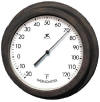
Thermometer
An instrument that
measures the temperature of a system in a quantitative way
Temperature
The temperature of
an object is that which determines the sensation of warmth or coldness
felt from contact with the object
|
|

Parts of a thermometer |
|

Barometer
Measures the air pressure of the air that's
pressing in all directions at ground level. The air's pressure is
caused by the weight of all the air above the ground pressing down (caused
by gravity). At sea level, air has a pressure of 14.7 pounds per
square inch. Instead of using pounds per square inch, barometers in
the U.S. measure the pressure in inches of mercury. This is how high
pressure would push mercury into a tube that has the top sealed off from the
air. A reading of 29.92 inches of mercury is the same as 14.7 pounds
per square inch. |
|

Anemometer
Measures wind force and velocity |
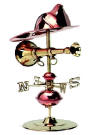
Wind Vane
Measures wind direction |
|


Hygrometer
Measures relative humidity (amount of water
vapor in the air compared to the greatest amount of water vapor it can hold) |
|

Precipitation Gauge
Measurement of rain, snow, sleet and hail |
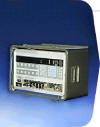

Radiosonde
An
instrument carried aloft, chiefly by
balloon, to gather and transmit
meteorological data. That's Eddie
Friedmen (friend of mine) letting a
weather balloon
with a radiosonde
loose. |
|
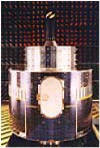
Meteosat
A European weather
satellite orbiting above the equator at an altitude of 23,000 miles.
It takes a photo of the Earth every 30 minutes as well as sending back
weather information and gathering data on the environment. |
|

EOS Spacecraft
This spacecraft
repeats its ground track every 16 days. It provides atmospheric
measurements over virtually every point on Earth in a repeatable pattern.
This permits an ongoing assessment of atmospheric phenomena changes in the
same geographic locations. |
|



Various Radar Pictures |
|

Weather Map showing
relative humidity |

Weather Map showing temperature change |

Weather
Map showing Isobars |
|
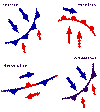
Fronts
Zone of transition
between two different air masses. Zone may be 20 miles across or 100
miles across. Significant different properties from one side of the
front to the other include temperature, dew point, wind direction, cloud
cover and on-going weather. |

Air Masses |
|

Weather Map
indicating Wind Speed
|
|

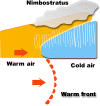
Cold Front
Cold air moves in,
pushing warm air above it.
Characteristics
of Cold Fronts
 | usually bring in
cooler weather, clearing skies and a sharp change in wind direction |
 | slope of a
typical cold front is 1:100 (vertical to the horizontal) |
 | tend to move
faster than all other types of fronts |
 | tend to be
associated with the most violent weather |
 | tend to move the
farthest while maintaining their intensity |
 | tend to be
associated with cirrus well ahead of the front and a broad area of clouds
immediately behind the front |
 | fast moving
fronts may be mostly clear behind the front |
 | associated with
squall lines (lines of strong thunderstorms parallel to and ahead of the
front) |
 | during winter,
cold fronts move into Oklahoma mainly from the Canadian prairies but
sometimes from the Artic Circle or the eastern Pacific |
|
|


Warm Front
Warm air moves in,
pushing out cold air
Characteristics
of Warm Fronts
 |
slope of a typical
warm front is 1:200 (more gentle than a cold front) |
 |
tend to move slowly |
 |
typically less
violent than cold fronts |
 |
although they can
trigger thunderstorms, warm fronts more likely to be associated with large
regions of gentle ascent, stratiform clouds and light to moderate
continuous rain |
 |
usually preceded by
cirrus first (1000 km ahead). then altostratus or alto cumulus (500 km
ahead), then stratus and possibly fog |
 |
behind warm front,
skies are relatively clear (but change gradually) |
 |
associated with a
frontal inversion (warm air overrunning cooler air) |
 |
on weather map, warm
front will be northeast of cold front and to the east of a surface low
pressure area |
 |
clouds and
precipitation prevalent to the north of the warm front (result from
low-level southerly winds in the "warm sector" of the cyclone rise up and
over the cooler, more dense air at the surface located north of the warm
front. This lifting leads to saturation, cloud formation and to some
form of precipitation) |
 |
in Oklahoma, warm
fronts are rare in the winter and non-existent in the summer |
|
|

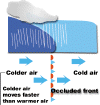
Occluded Front
Formed when a cold front moves faster than a warm front; cold front
catches up to and overtakes the warm front.
Characteristics of Occluded Fronts
 |
indicative of mature storm systems (storm about to dissipate) |
 |
most
common type of occlusion in North America is a cold-front occlusion
(occurs when the cold front forces itself under the warm front; the
weather ahead of the cold occlusion is similar to that of a warm front
while that along and behind the cold occlusion is similar to that of a
cold front |
|
|
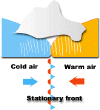
Stationary Front
Does
not move or barely moves
Characteristics of a Stationary Front
 | behaves like
warm fronts, but are more quiet |
 | winds on both
sides of a stationary front are parallel to the front |
 | typically form
when polar air masses are modified significantly so as to lose their
character |
 | cold fronts
which stall |
|
![]()
![]()